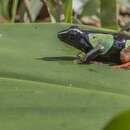Description
provided by AmphibiaWeb articles
General body shape rather stout. SVL 20-27 mm (M 21-22 mm, F 24-25 mm). Upper head surface, dorsum and flanks usually blackish without recognizable dorsolateral colour border. Yellowish rostral stripe present. Femur and humerus yellow to green, this colour extending as large flank blotches onto the flanks and sometimes onto the dorsum. Distinct orange flashmarks present. Tibia, tarsus and foot orange, with or without blackish crossbands and marblings. Iris mostly containing light pigment in its upper part. Rostral stripe often in contact with flank blotch. Specimens of unknown origin in the pet trade were more variable yellow colour in varying extension can sometimes be present on the dorsum. All intermediate states from a few yellow spots, to a reticulated yellow marbling or a dense yellow speckling are known. A greenish frenal stripe, often interrupted, can be present as well. Other specimens are nearly uniformly yellow dorsally and ventrally, with only a few blackish spots and marblings. In these specimens, the more distinct yellow surface in the flank blotch area is reminiscent of the typical colouration, but it is not clear whether they really are conspecific with M. madagascariensis. Venter, throat and forelimbs black with light markings (mostly whitish-blue, sometimes yellow to green). These being generally rather large, rounded, and situated posteriorly on the venter. Distinct horseshoe marking present, more extended in males. Femur, tibia (except flashmark area), tarsus and foot often uniformly orange, in other specimens with areas of black and yellow (the latter corresponding to yellow colour on the dorsal surface). Areas of femoral “glands” often darkly pigmented. In some specimens, femur nearly totally black with blue spots. In “variable” specimens, entirely ventral pattern sometimes replaced by a dense yellow marbling. Variation: Genetically, specimens from the Ranomafana area (in the general region where the types have been collected) are not placed in one clade with specimens from the Moramanga area. These south-eastern specimens which are to be considered as typical M. madagascariensis have a smaller body size but otherwise are not distinguishable from the central-eastern specimens by morphology or colouration. Similar species: M. baroni is more slender and has no reddish flashmarks, M. pulchra is less colourful dorsally and has no distinct yellowish rostral stripe.Taken with permission from Glaw and Vences (2007).
Andreone, F. and Glaw, F. (2008). Mantella madagascariensis. In: IUCN 2008. 2008 IUCN Red List of Threatened Species. www.iucnredlist.org. Downloaded on 22 April 2009.
- author
- Miguel Vences
- author
- Frank Glaw
Distribution and Habitat
provided by AmphibiaWeb articles
One known from Ranomafana (Ranomafanakely, Vohiparara). Two known from Beparasy, Besariaka near Moramanga, Marolambo, Niagarakely. It occurs from 700 to 1,050m asl in forest and forest edge, particular along streams (Andreone and Glaw 2008).
- author
- Miguel Vences
- author
- Frank Glaw
Life History, Abundance, Activity, and Special Behaviors
provided by AmphibiaWeb articles
Habits: Poorly known, along streams in primary rainforest. Active during the day on the ground. Calls: Short chirps, arranged in less regular series. Breeding occurs in streams, where larvae develop (Andreone and Glaw 2008).
- author
- Miguel Vences
- author
- Frank Glaw
Life History, Abundance, Activity, and Special Behaviors
provided by AmphibiaWeb articles
Vulnerable: extent of occurrence is less than 20,000 km2. Its distribution is severely fragmented, and there is continuing decline in the extent and quality of its forest habitat in eastern Madagascar.Its presence is not confirmed in any protected areas, but it occurs close to Parc National de Ranomafana. There is a need for careful regulation of the trade in this species (Andreone and Glaw 2008).
- author
- Miguel Vences
- author
- Frank Glaw
Madagascan mantella: Brief Summary
provided by wikipedia EN
Mantella madagascariensis, common names Malagasy painted mantella, Madagascan mantella, Madagascar golden frog, Malagasy mantella and painted mantella, is a species of frog in the family Mantellidae.
- license
- cc-by-sa-3.0
- copyright
- Wikipedia authors and editors

